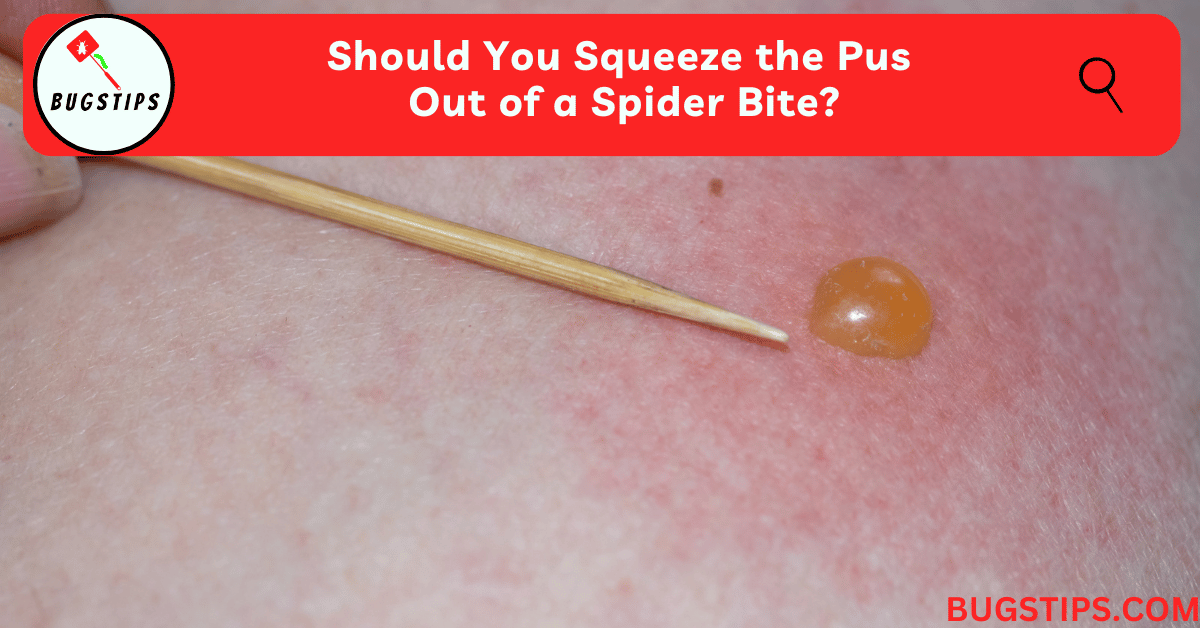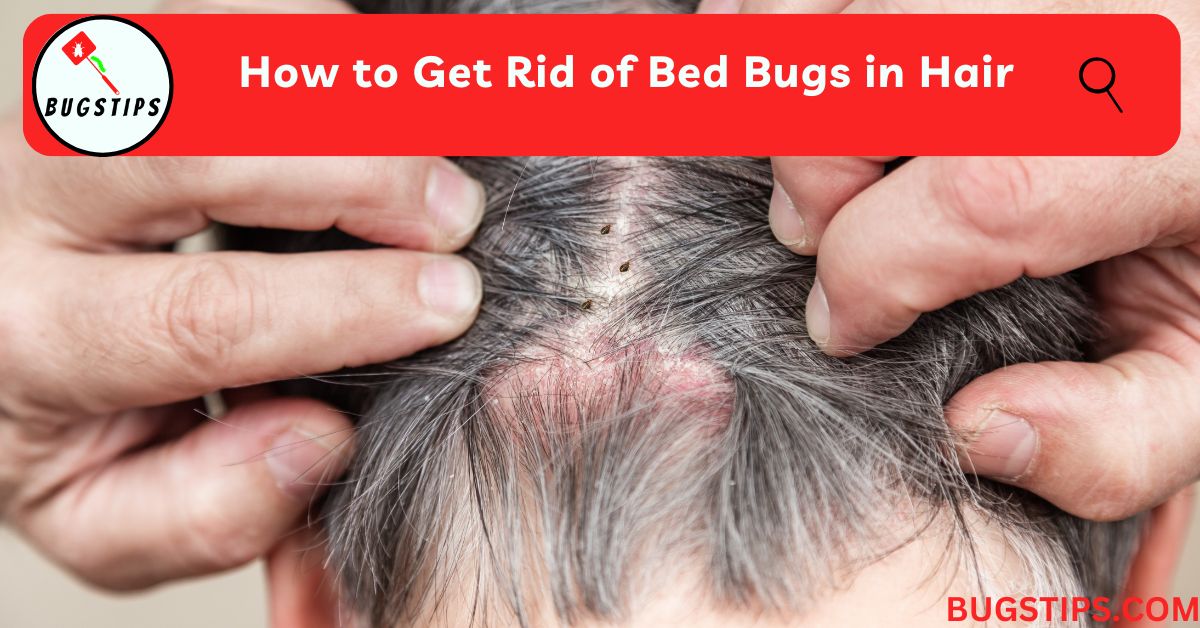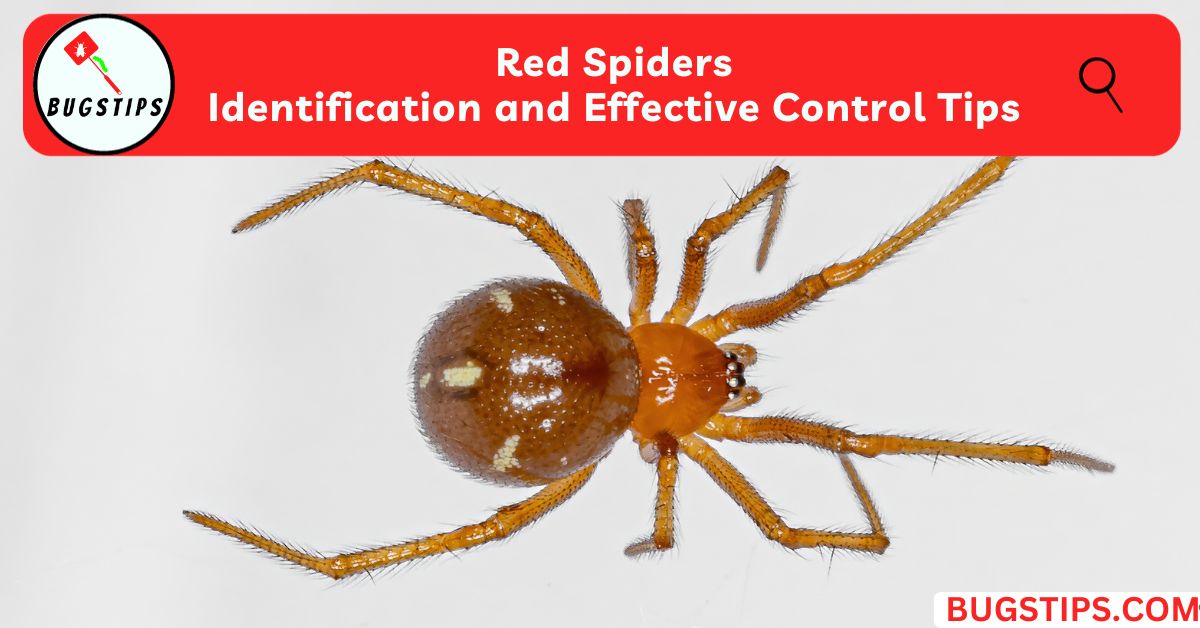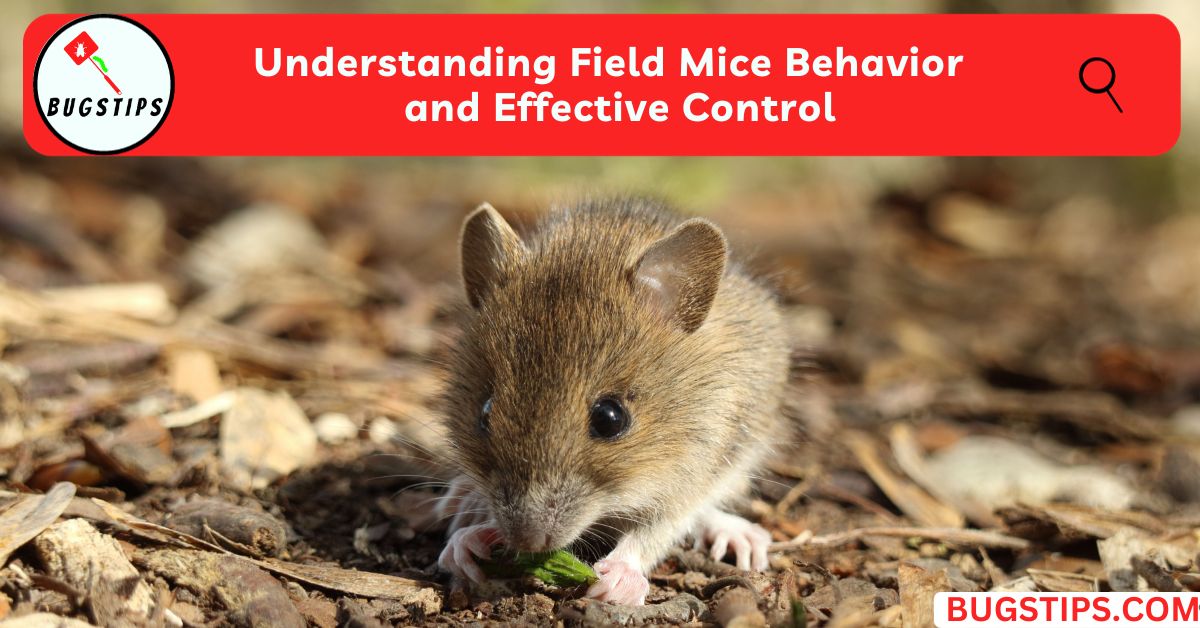This post may contain affiliate links which means as an Amazon Associate, this site may earn a small commission on qualified purchases made through links at no extra cost to you. Learn more on Affiliate Disclosure
Getting an insect bite is never fun, especially when it starts oozing pus. Spider bites in particular can create small, red bumps on the skin that fill with white or yellow fluid.
The sight of that fluid might tempt you to pop it like a pimple and squeeze it all out. But should you squeeze the pus out of a spider bite?
While it can be tempting to squeeze out spider bite pus, it is generally not recommended. Squeezing a spider bite can make the bite worse and increase your risk of infection.
In this article, we’ll explore whether you should squeeze that fluid out of a spider bite and provide tips on the safest ways to treat spider bites.
We’ll also cover how to identify spider bites, home treatment options, and when you need to seek medical care for a potential spider bite.
Should You Squeeze the Pus Out of a Spider Bite? Full Answer
The short answer is no, you should not attempt to squeeze out the pus or fluid from a spider bite.
While you may think draining the wound will help make the bite go away faster, squeezing or popping a spider bite can actually worsen the bite and increase your risk of infection.
Spider bites contain bacteria, venom, or other irritants from the spider’s mouthparts. Squeezing the bite can push some of this material further into your skin, spreading the infection deeper into the tissue.
Squeezing can also rupture blood vessels under the skin, leading to additional swelling, redness, and pain around the bite.
The pressure applied to squeeze out fluid can damage the tissues your body needs to heal the spider bite wound.
In rare cases, aggressively manipulating a spider bite by squeezing or poking at it can even cause the wound to turn into an abscess or ulcer. This requires more intensive medical treatment to heal properly.
Additionally, if the spider bite is from a venomous spider like a brown recluse, squeezing the bite can unintentionally spread the venom to surrounding areas of healthy tissue. This can damage a larger area of skin around the bite.
So while you may temporarily and partially drain some fluid from a spider bite by squeezing, the risks outweigh any potential benefits. It is safer to leave the bite alone and let your body naturally heal the wound instead.
Related Article – Are Banana Spiders Poisonous? Should You Worry?
How to Identify a Spider Bite
Identifying a spider bite can be challenging, as many common symptoms can also be caused by other factors.
But there are a few key signs that point to a spider as the culprit.
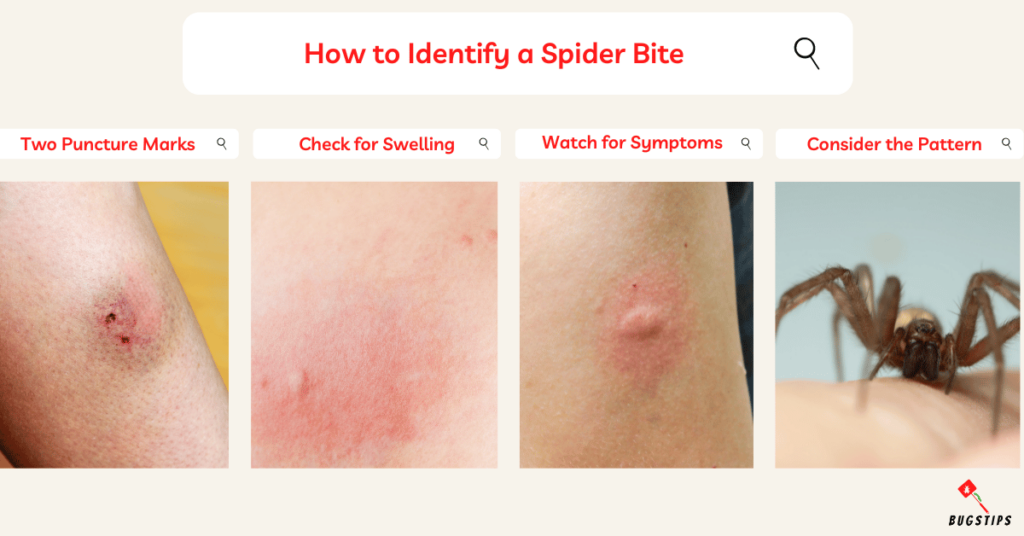
Look for Two Puncture Marks
- Take a close look at the bite and see if you can make out two tiny puncture points like you’d see from a snake bite.
- These marks come from the spider’s two fangs piercing your skin.
- Sometimes the bite marks are too small to really make out two distinct punctures though, But checking for any small indentations can help tip you off.
Check for Swelling
- One of the clearest signs of a spider bite is when the area around the bite starts to swell, turn red, and become painful within 2 to 8 hours after being bitten.
- The amount of swelling can vary quite a bit though depending on the type of spider and how much venom entered your skin.
- But any noticeable swelling or redness around a small puncture wound is a strong indication it could be a spider bite.
Watch for Symptoms
- Be on the lookout for concerning symptoms after a bite, like nausea, vomiting, fever, headaches, and joint pain.
- These types of flu-like symptoms can be signs you were bitten by a venomous spider.
- Non-venomous spider bites may just cause mild swelling and itching rather than systemic symptoms.
Consider the Pattern
- Often spider bites form a curved or linear line on the skin, which mirrors how a spider would have walked across your skin before biting down.
- So take note of any defined pattern or trail of small bites rather than a single larger bite mark.
However, not all spider bites are easily identifiable, and some may go unnoticed at first due to small marks or lack of significant symptoms.
You May Also Like – Do Wolf Spiders Make Webs?
What is the White Ring Around a Spider Bite?
Some spider bites develop a characteristic white or pale ring around the central bite mark. This ring is medically known as a “bull’s-eye lesion”.
This ring forms because the area immediately around the bite becomes swollen and inflamed.
This inflamed tissue presses on the blood vessels surrounding the bite, restricting blood flow.
The lack of blood flow causes the skin in this immediate ring to turn white or pale.
Meanwhile, the outer area around the swollen bite fills with blood and fluid, causing the larger outer reddened area.
This creates the bull’s-eye effect of a white or pale inner circle with an outer red swollen ring.
The presence of this bull’s-eye shaped lesion points to a spider as the likely source of the bite.
Other conditions like Lyme disease infections can also cause a bull’s-eye rash, but spider bites remain the most common cause.
While alarming in appearance, the white ring is merely a symptom of the body’s reaction to the bite.
It should subside gradually as swelling decreases and blood flow returns to normal. But be sure to watch for any spreading of the swollen area, which can indicate infection.
Related Article – Zombie Spiders | The Creepy Truth
What Can Be Mistaken for a Spider Bite
Spider bites are often mistaken for other insect bites and skin conditions that cause similar symptoms.
That mystery welt or spot on your skin that you assume came from a spider could very likely be from another culprit entirely.
Here are some examples.
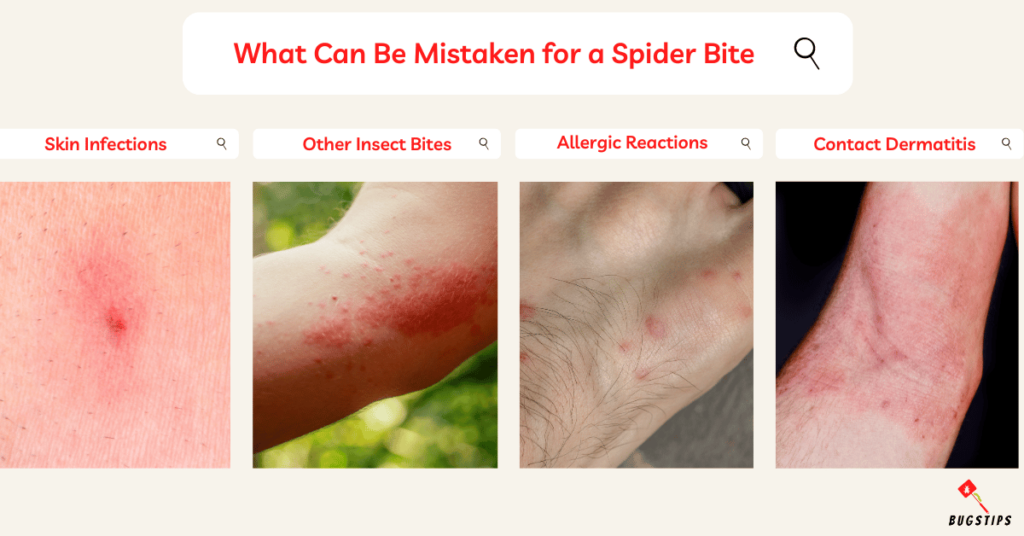
Skin Infections
- Bacterial infections of the skin, follicles, or glands can look like spider bites.
- Signs to look for are localized swelling, redness, pus, and tenderness.
- They often start as small pimples or pustules and may worsen quickly without treatment.
Other Insect Bites
- The differences are they appear in clusters or lines, not alone, and have no obvious fang punctures.
- Significant itching is also common.
Related Article – Do Thrips Bite?
Allergic Reactions
- Allergic reactions to foods, plants, or medications can cause hives or swelling similar to spider bites.
- Identifying features are the reactions are often widespread over large areas, may come and go, and have no clear bite site.
Contact Dermatitis
- Skin conditions like eczema and psoriasis flaring up can cause red bumps or rashes resembling bites.
- Characteristics are dry, irritated skin that may occur anywhere but often on hands, feet, and elbows.
- The rashes are also chronic and recurring.
If you suspect a spider bite but the symptoms don't fit, consider one of these other common culprits. Getting the correct diagnosis is key to proper treatment.
Related Article – 16 Green Bugs That Bite
When to Worry About a Spider Bite
Most spider bites can be treated at home and do not cause serious complications.
However, there are certain symptoms and scenarios in which a spider bite requires prompt medical care.
Seek emergency care if the bite has any of the following characteristics.
- Difficulty breathing, swallowing, or speaking after a bite. This could indicate anaphylaxis, an extreme allergic reaction that can become life-threatening.
- Signs of infection like oozing pus, expanding redness, and worsening swelling. Infection requires antibiotics.
- Spreading ulcer or blister with black tissue. This indicates possible necrosis from a venomous bite.
- Severe pain that does not respond to over-the-counter painkillers. Strong bite reactions cause extreme pain.
- Flu-like symptoms like high fever, headaches, nausea, vomiting, or muscle cramps. These signals systemic envenomation.
- Multiple bites. Higher venom doses raise complications.
- Bite on face, neck, hands, feet or genitals. Swelling here is especially dangerous.
Seeking prompt medical treatment for any concerning or severe spider bite symptoms can prevent complications and long-term damage. Do not wait and watch if a bite seems to be getting worse.
You May Also Like – Does Lavender Repel Spiders?
How to Draw the Poison Out of a Spider Bite
While our instinct may be to try and extract the venom from a spider bite, doctors actually advise against attempting to draw out the poison at home.
Trying to suck out the venom or using folk remedies can end up doing more harm than good.
The best way to treat a concerning spider bite is to seek proper medical care right away.
However, there are some natural methods that may help provide symptom relief for minor spider bites at home.
Home Remedies for Spider Bite Symptoms
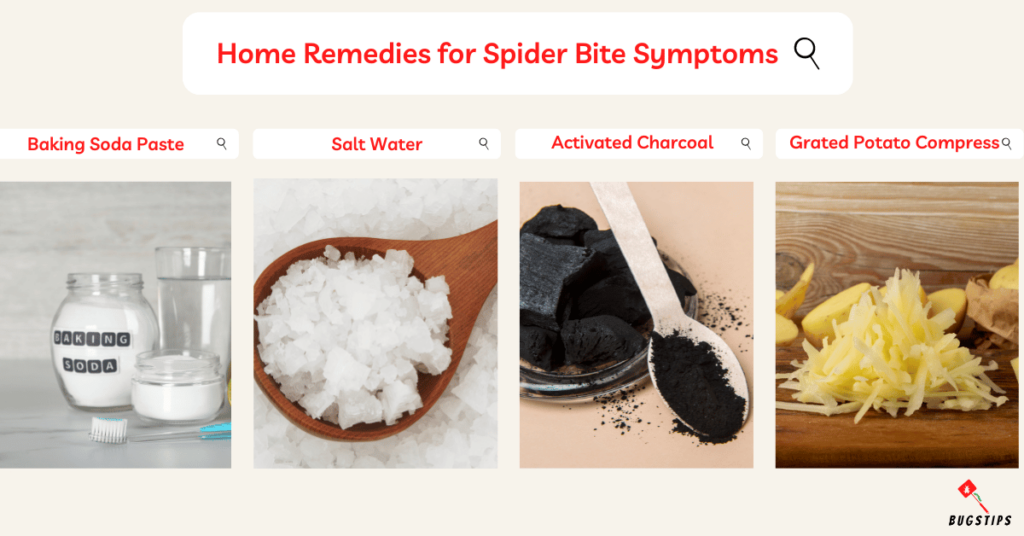
Baking Soda Paste
- Mix 1 teaspoon of baking soda with just enough water to form a thick paste.
- Apply this paste directly to the spider bite and let it sit for 5-10 minutes before rinsing.
- The alkaline properties of the baking soda may help neutralize the acidic venom injected by the spider.
Salt Water
- Make a saltwater solution by mixing 1 teaspoon of salt in 1 cup of warm water.
- Dip a clean cloth into the solution and wring it out so it’s damp but not dripping.
- Place the salt water cloth directly onto the spider bite for 10-15 minutes. The salt can draw out toxins from the wound.
Activated Charcoal
- Stir activated charcoal powder into just enough water to make a thick paste.
- Bandage this paste securely over the bite using gauze or a cloth.
- Leave it on for 30-60 minutes. The charcoal may bind to irritating compounds from the venom.
Grated Potato Compress
- Grate a washed, raw potato and spread the flesh evenly over a clean cloth.
- Place this potato side down onto the bite for 15 minutes.
- The potato’s anti-inflammatory properties can reduce swelling and discomfort.
While home remedies may provide some relief, they should not replace treatment for dangerously venomous spider bites.
Related Article – 8 Bugs That Look Like Lint and Bite
What Can You Put on a Spider Bite to Make It Better?
While most spider bites can heal on their own, using the right topical products can provide symptom relief and speed healing.
Certain creams, gels, and devices can soothe pain, itching, and swelling from a spider bite.
Here are some of the best products we recommend for any insect bite care and pain relief.
You May Also Like – Does Windex Kill Spiders? An Expert Analysis
Final Thoughts
While it can be tempting to try and squeeze out pus or fluid from a spider bite, doing so is not recommended. Squeezing a spider bite can push bacteria deeper into the skin, increase your risk of infection, and slow the healing process.
Instead, the best way to treat an infected spider bite is to keep it clean and covered. Allow any blisters to drain on their own.
You can apply warm compresses to help draw out fluid, but never try to forcibly drain or squeeze the bite.
If the area becomes increasingly swollen, red, or tender, seek medical treatment promptly. Signs like expanding redness, streaking red lines, pus, or flu-like symptoms after a bite indicate a possible infection requiring antibiotics.
With proper first aid and monitoring for infection, most spider bites can heal on their own within 1-2 weeks.
Resist the urge to pop blisters or squeeze pus so the bite can close up faster. And if in doubt about any symptoms, get evaluated by a doctor for appropriate care.
FAQs
What do infected spider bites look like?
Infected spider bites can appear red, swollen, and increasingly painful. They may develop pus-filled centers, feel warm to the touch, and show signs of spreading.
Do spider bites have a white head?
Sometimes an infected spider bite will have a white or yellowish head as pus and fluid builds up in the blister. However, not all infected bites will have a noticeable white head.
What happens if pus comes out of a spider bite?
Pus is a sign the bite is infected. See a doctor for antibiotics if pus is oozing out to prevent the infection from worsening.
How long does it take for a spider bite to pop?
An infected spider bite can take 1-2 days to pop or drain as the venom and toxins cause tissue damage and blistering. Do not try to pop or squeeze the bite.
Can I use a needle to drain the pus?
No, you should never try to drain pus from a spider bite at home. This risks further infection. Seek medical treatment for proper care.
What do you put on an oozing spider bite?
Gently clean and cover oozing spider bites with an antibiotic ointment and bandage. Elevate the area and apply a cold compress to reduce swelling and pain.
How long should a spider bite stay?
Most mild spider bites resolve fully within 1-2 weeks with proper wound care. See a doctor if symptoms last longer than a few days or seem to worsen.
Should you leave a spider bite uncovered?
No, always keep spider bites clean and covered with a bandage until fully healed to prevent infection.
Can I prevent spider bites?
To help prevent spider bites, wear long sleeves and pants when in wooded or grassy areas. Check shoes and gloves before putting them on. Also, shake out towels/clothes.
Resources – (for further reading)
Mayo Clinic – Spider bites – Symptoms & causes
Cleveland Clinic – Spider Bites: Signs, Symptoms, Diagnosis, Treatment
National Institutes of Health (.gov) – Poisonous Spiders: Bites

